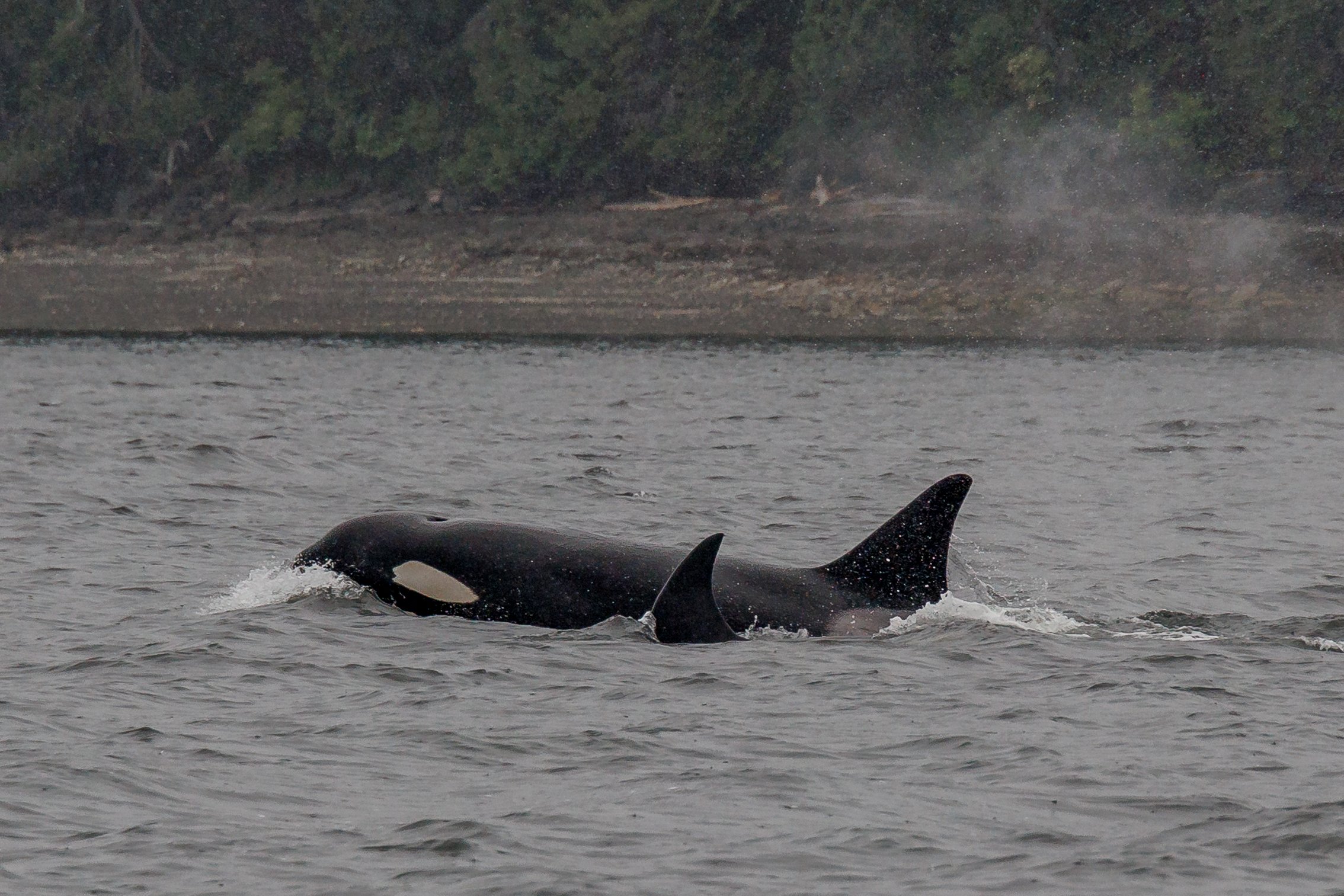June 9, 2023, 3:30 PM - T-party with the T100Bs, T124A2s, and T100E
Today included a lovely evening T-party in the Gulf Islands. A T-party occurs when multiple pods of transient orca spend time together, often taking this opportunity to mate, hunt and play together.
Today’s pods included:
T100B Freya ♀ (1997)
T100B1 Seidr (2010)
T100E Tharaya ♀ (2009)
T124A2 Elkugu ♀ (2001)
T124A2A Agafia ♂ (2013)
T124A2B Litton ♀ (2016)
There was plenty of action this evening, with actions such as pec slaps, tail slaps, spy-hops, cartwheels and breaching. The end of a successful hunt often ends with the energetic behaviour that today’s pod exhibited. A successful feed can lead to animal scraps floating in the water. When animal scraps are floating, gulls or eagles swoop in to grab a free meal of leftovers. It’s difficult to tell when a hunt has been successful because we can’t see what happens underwater, but bird swooping behaviour is a tell that a successful hunt has occurred. Orca need to eat up to 300 lbs of food each day and primarily feed on harbour seals, but they are also known to feed on harbour porpoises, sea lions and baby humpback or gray whales.
Orcas generally travel in their family pod, led by their mother, the matriarch. When females are old enough to be able to have their own calves, which is approximately 12 years old, they will be able to start their own new family pod. Males will typically travel with their mothers their whole lives, with some exceptions. Today’s group does have quite the exception, with T100E Tharaya travelling away from her family, the T100s, to spend time with the T100Bs and T124A2s. Our current hypothesis for why she might have done this is because she is in search of a male outside of her family group to mate with, as being 14 years old she is within the age that female orca will mate and give birth to their first calf. Another possibility is that she just missed spending time with her older sister, T100B Freya.
Stinky Rock was a highlight, as usual. On the east side of Valdes Island, within the Strait of Georgia is an unnamed rock that we as a company know as “Stinky Rock” and we look forward to the days that we don’t have to remember why we have named it Stinky Rock. The Stellar sea lions were laying in their usual place on Stinky, with the largest male placed at the top of the haulout. The Steller sea lions have begun to exhibit their mating behaviour before they begin to head off to their breeding grounds in Alaska. While in Alaska, the largest male Steller sea lions will hold down their mating rocks, surrounded by about 10-16 females waiting for him to breed with them, passing on his good genetics to their offspring. The male will fight off other males that dare to plant so much as a flipper on the rock they are residing on, sometimes to the death if neither male backs down from the fight for dominance.
To end today’s tour, we spent some time at the Gabriola Island bluffs. The sandstone of Gabriola Island along the Northumberland Channel is the oldest on the island, at approximately 74 million years old. Over the past 74 million years, the sandstone has slowly been eroded by wave action, creating intricate bubbles along the cliffside that are perfect for nesting cormorants. The cormorants collect any grass, leaves, twigs or seaweed that they think is good nesting material, and then they will stick it to the cliffside by pooping on it. Cormorant poop acts as a glue for their nests to stay in place so that when they come back from their winter grounds in Mexico to return here in early spring, some of their nest may still be here and they don’t have to rebuild too much.
Today’s photos were taken by Marine Naturalists Vanessa Vereschahen and Des Poier.
T100B Freya and her child T100B1 Seidr. Photo by Vanessa Vereschahen.
T124A2A Agafia. Photo by Vanessa Vereschahen.
There were lots of tail slaps during our trip. Photo by Vanessa Vereschahen.
T100B1 Seidr. Photo by Vanessa Vereschahen.
T100B1 Seidr’s flukes. Photo by Vanessa Vereschahen.
Seidr’s flukes are so ripped up! Photo by Vanessa Vereschahen.
T124A2B Litton. Photo by Vanessa Vereschahen.
T124A2A Agafia with his distinct flukes. Photo by Vanessa Vereschahen.
Big splash! Photo by Vanessa Vereschahen.
Photo by Vanessa Vereschahen.
Photo by Vanessa Vereschahen.
Photo by Vanessa Vereschahen.
T124A2A Agafia. Photo by Vanessa Vereschahen.
T124A2A Agafia and T100B1 Seidr. Photo by Vanessa Vereschahen.
T124A2A Agafia splashing away. Photo by Vanessa Vereschahen.
Surface tension is so cool! Photo by Vanessa Vereschahen.
T100B1 Seidr. Photo by Vanessa Vereschahen.
T124A2A Agafia. Photo by Vanessa Vereschahen.
T124A2 Elkugu - orca look very long when you get a photo from this angle. Photo by Vanessa Vereschahen.
The perfect combo! Photo by Vanessa Vereschahen.
Left to right: T124A2B Litton, T124A2 Elkugu, and T124A2A Agafia (can you spot the freckle in his eyepatch?). Photo by Vanessa Vereschahen.
T100B1 Seidr and T124A2A Agafia. Photo by Vanessa Vereschahen.
Photo by Vanessa Vereschahen.
T124A2 Elkugu. Photo by Vanessa Vereschahen.
T124A2A Agafia. Photo by Vanessa Vereschahen.
T124A2B Litton. Photo by Vanessa Vereschahen.
T100E Tharaya. Photo by Des Poier.
T124A2 Elkugu (back, full view) and T100E Tharaya (front, dorsal only). Photo by Des Poier.
Photo by Des Poier.
Photo by Des Poier.
Photo by Des Poier.































